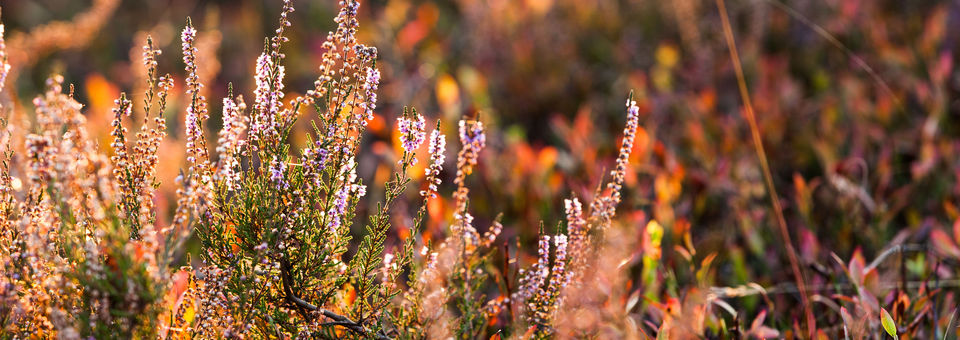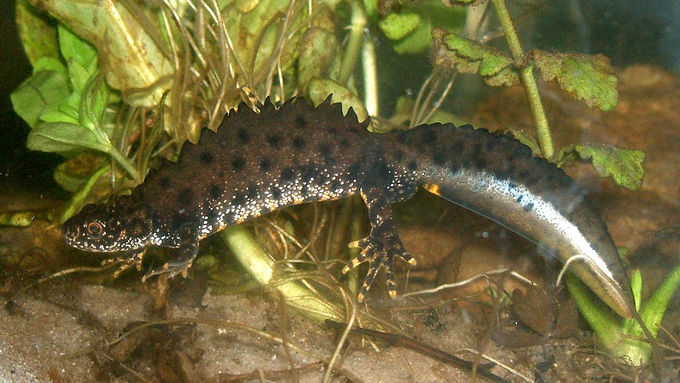Kammmolch/Crest newt (Triturus cristatus) © Rainer Theuer, Public Domain
download picturemain content
Protected Species
TRITURUS CRISTATUS (1166)
Crested Newt
With a body length of 12 to 18 centimetres, the Crested Newt is the largest native newt. Its upper side is coloured in dark brown to blackish; the underside is yellow to orange with black spots and patches. The pattern formed this way allows for individual discrimination of the animals. Males and females differ particularly in the mating season: Males then have a high, serrated crest on the upper side of the body. There are numerous white to yellowish spots on the warty rough skin of the flanks. A pearly-silvery band runs to either side of the tail. Female animals are less intensely coloured and do not wear such a succinct skin crest.
Habitat and biology
The Crested Newt has the longest aquatic phase of all native newt species. Therefore, the appropriate characteristics of the spawning and living waterbodies also have a greater importance. It is striking that waters and biotope complexes with large populations of Crested Newts often hold particularly species-rich amphibian communities. The most common one is the association with common newts.
The Crested Newt is considered a typical open landscape species which primarily occurs in lowland floodplains of rivers and brooks in open alluvial waters (e.g. back waters). Furthermore, in low mountain ranges, large humid forest areas with standing waterbodies rich in vegetation are populated. The species also occurs in gravel, sand and clay excavations as well as in quarries as secondary habitats. Most spawning waters have distinct riverine and underwater vegetation, are only slightly shaded and generally without fish. As a terrestrial living habitat, the Crested Newt uses moist deciduous and mixed forests, shrubs, hedges and gardens near the spawning grounds.
The aquatic phase lasts from the end of February/beginning of March until August or even until mid-October. Courtship and mating take place from mid-April until late May, occasionally extending to July. The development time of the larvae is two to four months. During this time, they grow to a size of up to eight centimetres and thus reach a larger body size than other newt larvae. They usually stay in the open water and are therefore especially threatened by predators. The metamorphosis of the larvae takes place from August to September. The young newts leave the waters from August to overwinter on land. Adult Crested Newt usually migrate immediately after the reproduction phase and look for their terrestrial winter habitats from August to October. For this, a maximum distance of up to 1,000 metres is covered. After two to three years, the young newts become sexually mature. The maximum lifespan in the wild is up to 18 years, in captivity up to 28 years. Because of this longevity, populations may survive even if reproduction fails for several consecutive years.
Occurrence
The Crested Newt is the rarest native newt species in North Rhine-Westphalia and is classified as "Vulnerable" (VU). The main areas of distribution are in the lowlands; in mountainous areas, the species is missing in locations above 400 m.
In Lower Saxony, the Crested Newt is also listed as "Vulnerable" (VU) in the Red List (2013). Its main areas of distribution and the largest populations are in the eastern, central and southern parts of the country, e.g. in the Weser-Aller Plains and Geest, partly in the Börden, in the northeastern half of the natural region "Lüneburg Heath and Wendland" (e.g. Elbe valley) and in the Osnabrück area. The exact population figures in Lower Saxony are difficult to assess. Numerous surveys and examples have shown that the total population is declining. Many occurrences have only small populations. The very large populations are almost exclusively situated within Natura 2000 sites.
Threats
The primary threat for the Crested Newt is the loss or degradation of spawning waters and terrestrial habitats. There are also restrictions due to changes in the water balance in wetlands or the deterioration of water quality as a result of nutrients and contaminants. In addition, the species is endangered by the conversion of grassland into agricultural land and intensive grassland use around the waterbodies as well as the fragmentation of habitats and the migration routes. Increasing shading of the waters can also devaluate spawning waters for Crested Newts.
Types of action
Basic implementation actions for the protection and improvement of the conservation status of the Crested Newt are the maintenance, development and, if possible, the creation of spawning waters and suitable terrestrial habitats and linear landscape elements. Improving the water balance should also be aimed at to stabilize a high groundwater level in wetlands and lowlands, as well as maintain and develop dynamic plain areas and extensive wetlands. Around the spawning waters nutrient and pollutant inputs should be reduced or prevented, if applicable by setting up adequate buffer zones. The spawning waters should be without fish stock; long-term removal of fish should possibly be carried out, unless the waters are periodically dry. In addition, appropriate amphibian protection actions (e.g. drift fence actions, permanent amphibian control system) should be set up along the roads in the area of migration corridors.
Actions within phase 1 of the LIFE IP
In the first phase of the project, seven actions will be implemented in North Rhine-Westphalia, which will focus on improving the conservation status of the Crested Newt. This often includes improvement actions for the habitat type (3130) and for other species, such as the Common Spadefoot (Pelobates fuscus) or the Floating Water-Plantain (Luronium natans). In Lower Saxony, no specific actions are planned for the Crested Newt in the framework of the LIFE IP, but synergy effects within the implementation of actions for other focus species and habitat types are to be expected.
Related Topics
additional information
Further Links
- Species profile „Crested Newt“ – State Agency for Nature, Environment and Consumer Protection (LANUV NRW) (in German) (external link opens in a new window)
- Implementation notes for the protection of the Crested Newt – Lower Saxony Water Management, Coastal Defence and Nature Conservation Agency (NLWKN) (in German) (external link opens in a new window)
- Species profile „Crested Newt“ – German Federal Agency for Nature Conservation (BfN) (in German) (external link opens in a new window)
- German Prioritised Action Frameworks (PAF): Crested Newt, Page 131 – German Federal Agency for Nature Conservation (BfN) (in German) (external link opens in a new window)
- Red Lists and complete species list of Amphibians and Reptiles in Lower Saxony and Bremen (NLWKN) (in German) (external link opens in a new window)




